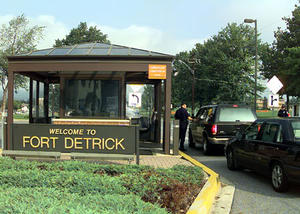More delays in opening Fort Detrick BioLab
DHS’s new BioLab at Fort Detrick, Maryland, is hobbled by a series of flaws and glitches which have prevented researchers from moving into the facility years after it had been dedicated; the most serious problem was the placement of valves that allow access to HEPA filters in biosafety level 3 lab; the filters must be decontaminated or replaced every few years, but the valves to let workers into the air ducts were too far from the filters

Entrance to Fort Detrick // Source: .myspace.com
Researchers continue waiting to move into the new DHS lab at Fort Detrick, years after the building was dedicated, after an endurance test uncovered flaws in the building (see “NRC Panel Has “High Confidence” in Fort Detrick BioLab’s Security Procedures,” 9 March 2010 HSNW). The most serious problem was the placement of valves that allow access to HEPA filters in biosafety level 3 labs, said Pat Fitch, lab director for the National Biodefense Analysis and Countermeasures Center. Air flows out of the lab space and is filtered before it exits containment suites. The filters must be decontaminated or replaced every few years, but the valves to let workers into the air ducts were too far from the filters, making it challenging for someone to safely access the filter.
Fitch said he would need a subcontractor to make new valves and install them closer to the filters, which could take four to eight months. “This is about risk management,” Fitch said. “It’s not impossible to manage the HEPA filters the way they are right now; it’s just not where I want to take my risk. So I would rather delay four months and put the valves in now than wait three years until one of those HEPA filters needs to be changed and be arguing about what the safe way is to change them.”
Frederick New Post’s Megan Eckstein writes that Fitch and others at the Battelle National Biodefense Institute, which will operate the lab, found other problems in the biosafety level 3 suites. They realized that, under the right circumstances, contaminated water might bubble back out of the drains on the lower floors of the building. BNBI plans to install water level monitors and a system that would prevent backwash.
A decontamination practice that involved changing a room’s air pressure wound up cracking a ceiling in the biosafety level 3 area — a problem that occurred last June, though at the time no one knew the underlying reason. Fitch said that would be a quick fix, but time was lost figuring out what had gone wrong.
Eckstein notes that this past winter’s atypical weather helped point to a few other problems. Most notably, the biosafety level 4 labs’ air pressure monitors determine a room’s appropriate air pressure using outdoor conditions as a reference point. The outdoor sensor, however, did not fare well in winds up to 40 mph. The sensor triggered a
